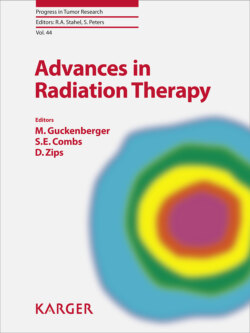Читать книгу Advances in Radiation Therapy - Группа авторов - Страница 21
На сайте Литреса книга снята с продажи.
Immunological Effects of Radiation, Rationale for Combination Therapies
ОглавлениеLocal tumour irradiation itself alters the tumour microenvironment and may support antitumour immunity, especially in combination with immunotherapy [51]. The direct cell kill by irradiation exposes a variety of tumour-associated antigens and leads to a release of danger-associated molecular patterns, or DAMPs, activating the innate immunity and thus paving the way for effective tumour eradication [52–55]. Surviving tumour cells show upregulation of MHC-I and NKG2D [56] and become more vulnerable to attack by T cells. In addition, the release of proinflammatory cytokines triggered by tissue damage through irradiation may polarise the immune response to a Th1 type, which also helps to support antitumour immunity. Primed and activated T cells will enter irradiated tumours more easily than nonirradiated tumours, for example due to increased expression of VCAM-1 in the tumour vasculature and the altered cytokine milieu [57, 58]. In in vivo models with more than 1 tumour in 1 animal, the combination of radiation and immunotherapy has been described to elicit “abscopal responses,” with tumour shrinkage not only in the irradiated tumour but also in non-irradiated lesions in the same animal [59, 60]. This effect has also been observed in the clinic [61–63]. However, irradiation alone only rarely leads to antitumour immune effects in patients, and abscopal effects have only been described in a few case reports. This might be explained by the upregulation of immunosuppressive mechanisms, like the induction of Treg cells and a possible Th2 polarisation after irradiation [64, 65]. Tumours might also be able to upregulate PD-L1 after irradiation [66].
